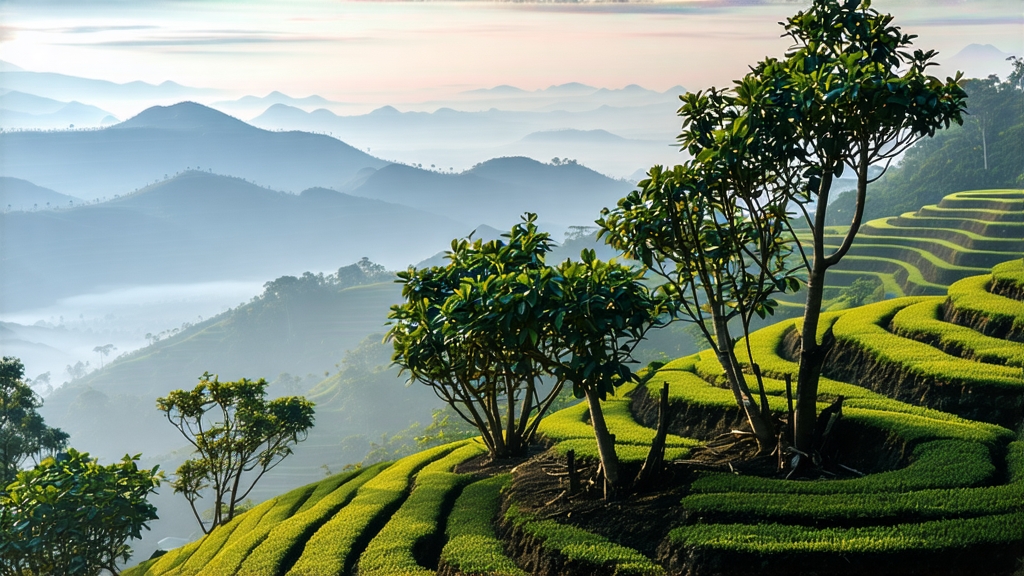
If oolong tea is the most virtuosic family within Camellia sinensis, then Phoenix Dancong from Guangdong Province is its most flamboyant soloist. Neither a place nor a single cultivar, “Dancong” literally means “single bush,” a name that hints at the obsessive clonal selection practiced for almost nine centuries on the phoenix-shaped ridges of Feng Huang Mountain. Growers noticed that individual old trees produced infusions that mimicked the scent of flowers, fruits, even spices. Instead of blending, they propagated each aromatic marvel by cuttings, creating what is now a living library of more than eighty recognized fragrance types, from the celebrated “Honey-Orchid” (Mi Lan Xiang) to the elusive “Ginger Flower” (Jiang Hua Xiang). The result is a tea that smells like it has been secretly barrel-aged with jasmine, lychee, and brown sugar, yet the only ingredients are leaves, fire, and time.
History begins with Song-dynasty legends. When the young emperor Zhao Bing fled Mongol troops in 1279, soldiers of the Southern Song are said to have refreshed him with large, leathery leaves picked from wild trees on Wu Dong Peak. The infusion’s perfume revived the court, and the grateful sovereign bestowed the name “Song Zhong,” a moniker still reserved for the oldest surviving bushes now guarded like bonsai giants at 1,100 m above sea level. During the late Ming, Buddhist monks systematized charcoal baking techniques learned from Fujian’s Wuyi Shan, giving Dancong its signature deep, roasted bass note that balances soaring floral highs. By the 18th century, the tea traveled the maritime tea routes to Southeast Asia, where Chaozhou migrants brewed it gongfu-style in tiny clay pots, cementing its reputation as the connoisseur’s choice for dim-sum parlors from Bangkok to Penang.
Botanically, Phoenix Dancong belongs to the Shui Xian (water sprite) genetic cluster, but centuries of sexual reproduction within an isolated mountain pocket have produced an unusually broad leaf chemistry. Trees are allowed to reach three to five meters, their taproots mining iron-rich laterite and quartz veins that refract morning mist into slow-release humidity. Leaves are broad, undulating, and tinctured with a reddish edge—the tell-tale sign of generous anthocyanins that will later translate into burgundy-colored infusions. Because each fragrance type is clonally stable yet genetically distinct, farmers harvest every bush separately, a laborious ritual that explains why true Dancong is never cheap.
Crafting Dancong is a choreography of wilting, bruising, oxidation, and fire that stretches across twenty-four hours and three lunar phases. Picking starts at dawn when two leaves and a bud still hold the chill of night; the goal is to capture the “mountain energy” (shan qi) before the sun volatilizes precious aromatics. The leaves are spread no thicker than two fingers on bamboo trays and allowed to sun-wilt for exactly twenty minutes—long enough to soften cell walls, short enough to lock in green freshness. What follows is the most photogenic step: yao qing, or “rocking the green.” Workers toss the leaves into the air and let them rain down onto the tray, a rhythmic clapping that bruises edges and triggers enzymatic browning. The pace accelerates from gentle sway to vigorous shake, monitored only by the sound: when the rustle turns from velvet to parchment, oxidation has reached 30 %, the sweet spot for Dancong’s half-fermented signature.
Oxidation continues overnight in woven bamboo baskets nested inside cloth-lined wooden boxes. Here the leaves sleep, exhaling fruity esters that smell like ripening plums. At dawn the baskets are opened, and the now mahogany-rimmed leaves are flash-fired in rotating drum ovens at 200 °C for ninety seconds—just enough to fix color and arrest enzymes. The crucial act, however, is the charcoal bake. Using only lychee or longan wood, artisans maintain a low ember for eight to twelve hours, repeatedly wrapping the cooled leaves in linen cloth and returning them to the ash-covered brazier. The cycle may be repeated up to three times over the following month, each bake lowering moisture by fractions of a percent while layering caramelized sugars that yield the famous honey-lock finish. Master bakers judge readiness not by timer but by aroma: when the dry leaf exudes a scent of toasted